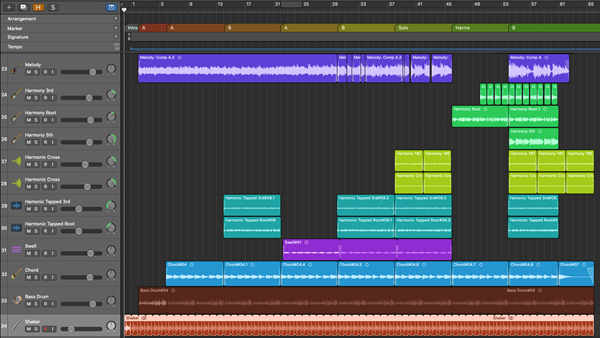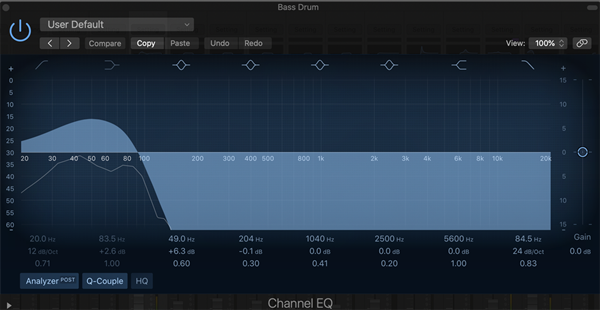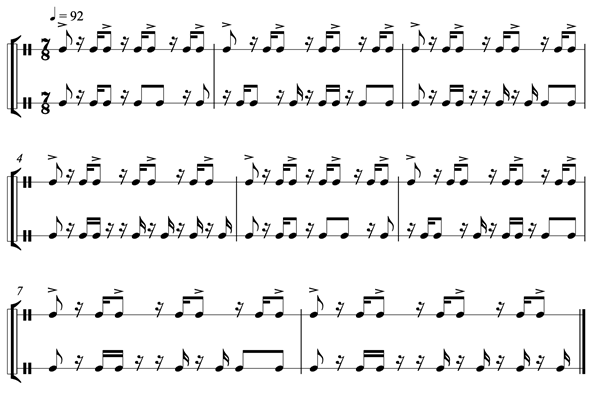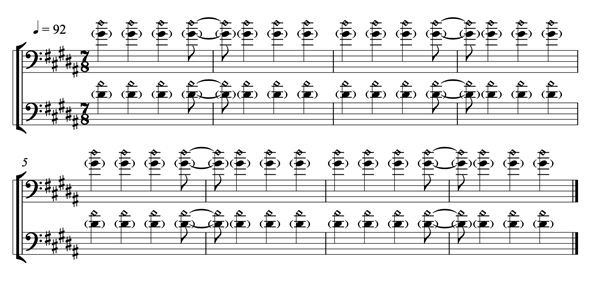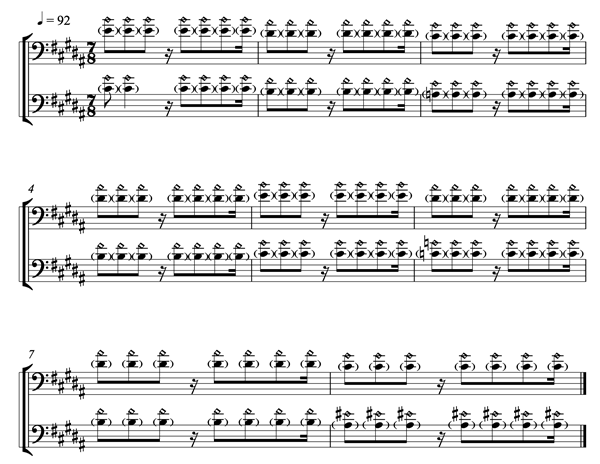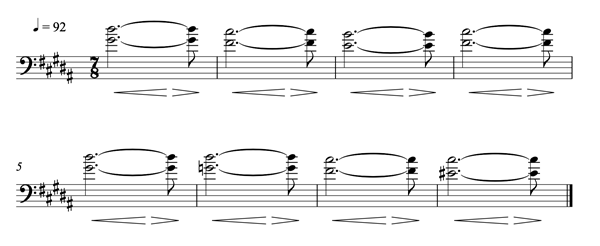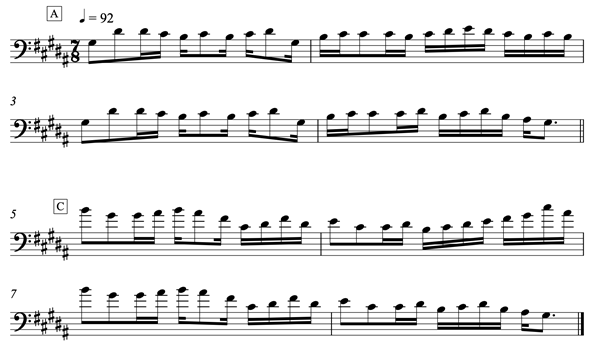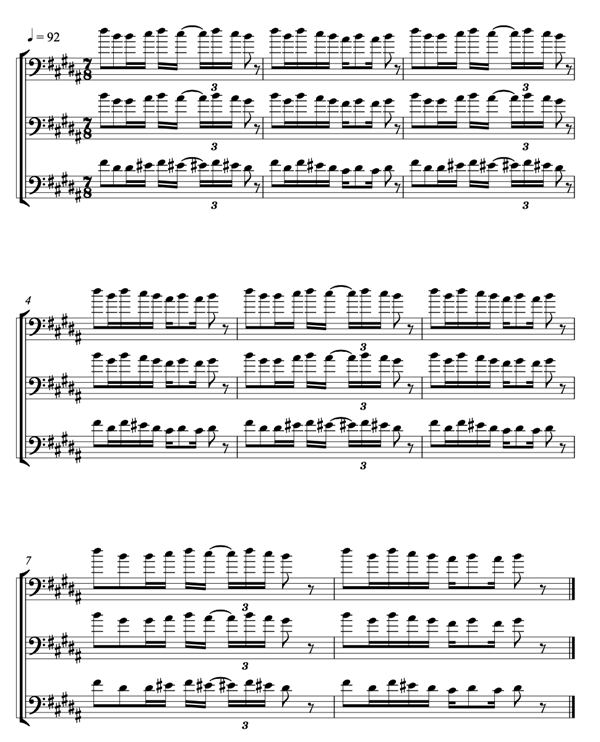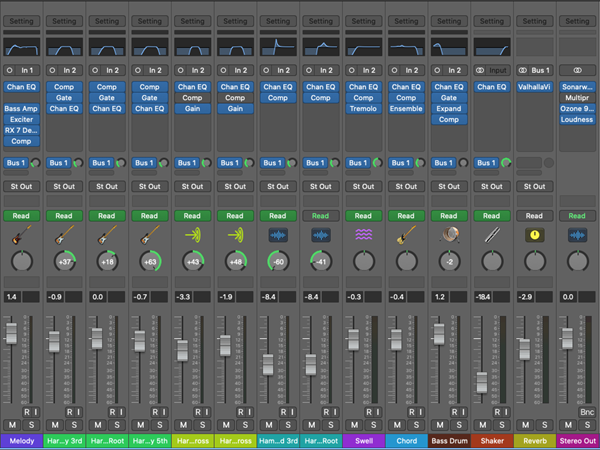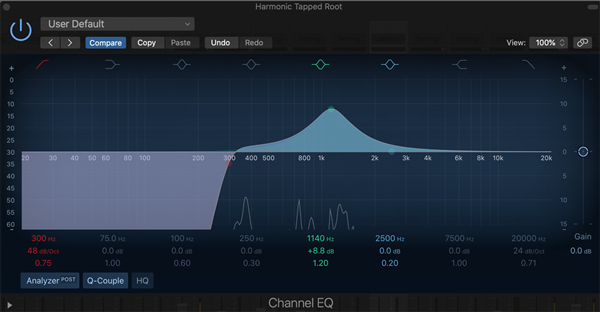Watermans pt 1 - Looping with a P-Bass
As I was learning and developing the arrangement of the tune Watermans for the full arrangement with Second Circle (link), I practiced a few different approaches to performing the melody on the bass guitar. There were a number of challenges in creating good articulation and representation of the tune on the 6 string Overwater bass. I hoped there could be some interest in transposing the melody to a different bass guitar that inherently contains vastly different tonal and physical performance qualities.
Click here to read the post about the piece and the Second Circle full band arrangement and a brief.
The aim is to explore Watermans on a vastly different instrument and note what differences arise in the creative practice and decision making process. The brief set requires all sounds to be created from my Fender 50's Reissue Precision Bass (lovingly named Nina) with the single exception of a shaker loop to play along to (instead of a click track) and to give some high end presence and time feel to the piece.
The Fender 50's Reissue Precision Bass
Stats
- 50's single coil split pick-up
- Single tone control and volume
- 44.45mm nut width
- 34" scale
- 4 Saddle American Vintage Bass Bridge 19mm/20mm string spacing
- 20 frets
- 7.25" Fingerboard radius- vintage C shape
- 4.3kg
The first decision made was to transpose the tune from is original key of E minor, up a major third (or down a minor 6th) to G# minor. The difference in range between the P-Bass and the Overwater (lovingly named Maria) bass is substantial. The P-Bass holds a pitch range of E1 - Eb3, two Octaves + Major 7th within 4 strings and 20 fret positions.
In comparison, the Overwater boasts an extended range of B0 - D5! Four Octaves and a Minor 3rd over 6 strings and 24 frets. This range was fully exploited in the Second Circle rendition of the piece but in order to obtain full utility on the P Bass, the tune was transposed so that its highest range extremity coincided with the highest pitch of the Watermans melody; which in the key of Ab Minor is an Eb, the 5th scale degree.
In a early attempts experimenting with creating accompaniment with a loop pedal over a different tune Gerry Commane's, which Second Circle will also release a rendition of with just percussion and bass guitar; one of the issues in the process was that using a loop pedal as a live function, requires a significant amount of time to set up each layer. If a mistake is made, one usually has to start again. As one can tell from this video, a couple of minutes are required to set up the accompaniment. In this experiment then, I decided to use loops created on the bass within Logic Pro X. Here, loops could be manipulated with various effects and used in a 'drag and drop' fashion to build an accompaniment base with with to perform the tune.
Creating the different parts
When we listen to a piece of music we may not think about how much of the frequency band is utilised. On orchestra or pop band by their evolved natures cover the typical spectrum of sound we enjoy in recorded music.
When composing with a single instrument, we lose the range of sounds and pitches available, unless its a solo piano for example with the range to cover the vast majority of this space. A bass guitar however, especially a 4 string, has a vastly limited range and higher frequencies would only exist in barely audible overtones or finger/string noise. This obviously leaves us with a rather large frequency spectrum gap. The desire to fill these 'gaps' that usually exist outside of the bass guitar's typical range, was the challenge of this arrangement.
The final product ended up with 12 tracks of layered bass in total:
Some of this arranging process was naturally thought-out from wishing to fill these gaps such as being made to specifically cover a particular frequency spectrum, such as with the shaker and 'bass drum'; and other times allowing the idea to just emerge and fulfil whatever is appropriate, or be discarded.
From the outset, it was going to be difficult to create some sort of high frequency rhythmic element to act as a shaker or hi-hat/cymbals above the 6kHz (brilliance) range without more extensive knowledge in sampling and sound manipulation; but a separate challenge I may address later in a separate piece. As such, the recorded shaker loop was the first element and the grounding for the time of the entire track. Working with loops requires precise performance timing to allow effective continual expression of the repeated musical idea between the end of one iteration and the start of the next, so this underpinning was the first foundational logical decision made in constructing this piece.
Creating the 'Bass Drum'
Following this was the equally foundational decision to build the groove from the opposite end of the frequency spectrum. The 'bass drum' recreation was the next logical step. After some experimentation a light thump on the lowest string on the bass (E) gave the closest desirable sound on the bass and sits nicely within the range of a typical bass drum (82.4Hz). The only other contender was hitting the body of the bass with a soft fist. This however wasn't too useful, the passive nature of the pickup system meant the signal volume was too low and would have made for more difficult sound manipulation later. In hindsight, it could have been possible to detune the string somewhat to hear a 'sub-ier' sound, but this idea didn't occur to me at the time. Again, something to attempt next time.
While this sound was part of the way to fulfilling the bass drum role, I felt it was still sounding too much like a bass guitar. The recording required some processing to 'tighten it up'. Some simple eq processing, with a high cut and low boost, with a touch of compression and an expander finalised the sound.
'Bass Drum'
'Bass Drum' - No FX
'Bass Drum' and Shaker
Now the basic groove was established I opted to build harmonic layers. If this was a tune I was arranging and didn't know quite so well I likely would have recorded a guide version of the tune first. Practicing this tune for quite some time in preparation for the previous full band recording meant I could explore harmony ideas whilst holding the tune against the ideas in my mind's ear.
Just allowing a bass guitar to create all of the harmony immediately bring range into question. Range for harmonic expression was going to be difficult due to the Lower Interval Limit - the idea in arranging that dissonant intervals shouldn't be used in low registers, because it creates a beating pattern in the waveform.
So creative harmonic and voicing decisions were framed by using as few notes as possible, and would require heavy auditing, to be as precise and concise as possible at portraying the harmonic idea.
I also knew, wanted the harmony to be simpler and similar to the original recording for this piece to act in contrast. This lends itself to the above limitations well. The harmonic complexity in the full band Second Circle arrangement would have been exceptionally difficult to recreate with the limited range and timbral scope of the bass guitar and particularly this Fender 50's reissue p bass.
In most typical popular music recording processes the drums and bass are recorded first, I was aware however that playing a 'bass line' a one typically would in this situation may lead down an avenue of ideas that eventually wouldn't fit or compliment the melody. this is a usual concern for me, and even more so - now the melody was going to be performed on the same instrument. Melody had then to be next, to ensure all subsequent melodic and harmonic ideas had context and boundaries to not obscure the melody.
After the melody was recorded the next task challenge was to fill as much sonic space in between everything. The bulk of that would come from the main chords which contained the lowest sounding notes and a typical strong set of voicing options: Root - 5th - 3rd. The 5th interval in the middle bass guitar register creates strong foundation and a great deal of space and the 3rd adds the colour. A single 10th interval could have done the same job, but would have left more 'space'. The addition of the 5th was a no-brainer decision, for thick decisive harmonic underpinning.
As mentioned before, the harmony was chosen to be similar to the original (i.e. i - bVII - bVI) and much simpler than the full Second Circle version, with the exception of using a 8 bar harmonic sequence rather than a 4-bar as per the original recording.
The full harmonic sequence:
Once the melody, harmony, bass drum and shaker we all in place and acting as a framework. The next job was to fill-the-gaps in as tasteful way as possible, all whilst being wary of the inevitable clashing and chaotic nature that recording many parts in a similar range offered by the bass would allow. A common idea used by solo bassists Victor Wooten and Michael Manring are the use of natural, false and tapped harmonics. Utilising these was going to be the obvious way to occupy the space in the higher registers.
The tune though was paramount in being clearly expressed. Quite often in music the main melody is on the top, so to speak, of any and all supporting sounds, whether in pitch or volume (if the melody is lower in pitch). As the tune in this instance was to be in a low/mid-range, then any ideas covering of the upper registers and frequencies needed to not overpower or distract from the melody. What followed was a process of generating ideas based around this frame and criteria: 1) ideas cannot overpower or distract from the melody 2) must be higher than the melody's range. In order to satisfy these criteria, a rhythmic approach was decided which led to the generation of what in the track listing is the 'Harmonic Cross' and the 'Harmonic Tapped'.
The Harmonic Cross was a false harmonic cross rhythm pulse that sits against the general groove.
(note: The high gain and compression required here to bring out the notes accentuated the noise level in my recording system, which I was unable to completely eradicate)
The Tapped Harmonics were exactly that. Two tracks blended in a simple 3rds harmony, and a rhythmic pattern that was inspired to complement the 'bass drum' sound.
Tapped Harmonic - With Processing
Tapped Harmonic - Without Processing
All Harmonics
The swell was then added as a non-rhythmic approach to filling out some mid-range space. As all other parts were inherently rhythmic in nature, this satisfied a desire to have some sort of 'pad' to act as sonic glue for the rest of the ideas. This sound was achieved with a Game Changer Audio Sustain pedal.
The Melody and Harmony lines
The melody on this particular bass has an aggressive and biting tone which lends it self to naturally using variations in articulation to highlight certain parts of phrases that can be heard especially in the solo section (1:35). The aggressive nature of the tone comes from the almost 'scratchy-ness' and clicks of the string being played. Part of this comes from how the bass is set up, i.e. not in a way to clearly and cleanly express a high-range melody. The lower action creates some string buzz against the frets creating this tone which generally works well for dynamic bass lines that this bass is more suited to i.e. rock, funk, and soul music.
It isn't often a bassist gets to harmonise one's own lines, the following was a indulgence bordering on my inappropriate criteria mentioned earlier. However, I justified this idea as it mirrors and harmonises the C melody, supporting it rather than detracting from it. The result was a rather interesting triadic block harmony (1:54) segment that underpins a final short improvised section.
Once all the above parts were recorded and processed, I felt there were no other musical ideas I could feasibly and reasonably add in without detracting and muddying-up what was already there. That was the point chosen to leave the arrangement and move on to the final processing. Most of the general processing (EQ, compression) had been done during the recording process. The bass drum and tapped harmonics for example were EQ'd as soon as was possible. This was important as the subsequent decisions were based on what could be heard at that particular point in time. If all the parts had been recorded without being processed to 'clean up' and organise the sounds then the track would have lost clarity of ideas very quickly, and would have ended in less content. For example: the taped harmonics required the fretting of a note lower than the desired pitch. As can be seen, EQ manipulation was severe in most cases in order to reduce surplus instrument noise and create clarity and space, either cutting unnecessary frequencies or boosting particular resonances to bring harmonics out further.
Tapped Harmonics - Without Processing
There was the possibility that further processing, etc could free up other sonic space for more musical ideas to occur, and I'm sure if pushed there is more to find, however I was inclined to leave it as it was, minus some further tweaks. The piece felt almost as complete as it could. Each idea had a role, space, and was clearly expressed. This in itself was an exercise in creative control, my natural tendency to continue tweaking, adding/subtracting, perfecting, complicating, etc was surprisingly easily put to rest. Working from a known set of limitations from the outset created by this particular instrument's attributes and the piece itself seemed to allow a more creative use of time and energy than I would usually experience from a completely open brief.
Performing the melody proved tricky on this particular instrument not in the application of technique but in the melodic tone. This Fender 50' Reissue Precision Bass Guitar, as the name suggests, attempts to recreate the tone of the original 50's model. This was the main reason I choose this particular instrument out of my personal collection to attempt this piece. It would be difficult due to its tonal limitations and lack of flexibility where other basses have a much larger range of tonal flexibility and potential. The only way to adapt tone directly on this instrument, other than playing technique, is via a volume control and a tone sweep, both ended up being used minimally. This leads to the question that would less post-recording sound manipulation be required if a more tonally flexible bass was used? Possibly, however in a project such as this there would still need to be some post-recording processing done on any bass guitar to remove unwanted noise (finger noise, string scrapes, string ring, harmonics, fundamentals, etc) to create clarity in the mix.
All in all, the melody itself was the trickiest part, and the end tone product was not one I was 100% convinced with. The tone is rough, has bite and is rugged. Again part of the nature of the bass guitar but not particularly appropriate for a melodic role in this context; this became much more apparent to me on reflection. During the experiment I was very much caught up in the time frame I had set myself and in the overall completion of the project. More time could have been spent experimenting with the tone of the P bass, perhaps adapting the set up to allow less string buzz and soften the tone. Generally though, I feel the experiment was a success, and a convincing example of what can be achieved with a single tonally limited instrument.
Thank you for reading. If you have any questions/comments please feel free to get in touch.
Posted In: Reflections on Practice
Tagged: Commentary, P Bass, Looping, Watermans
← Back to Recent Posts
